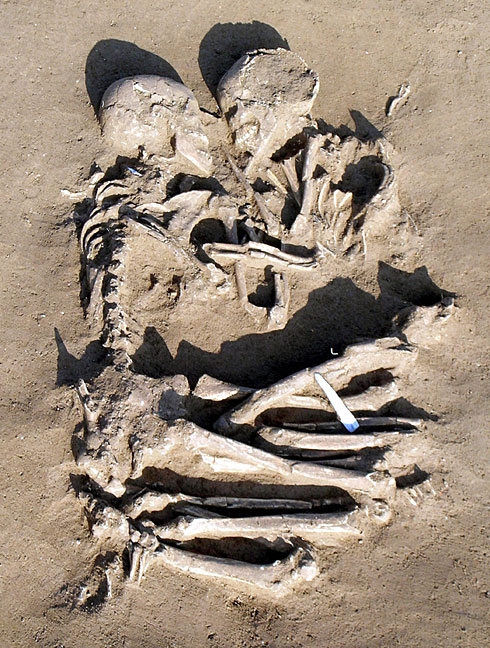Today’s discussion on soulmates and the nature of love in class today reminded me of an AP story I’d read about a two neolithic skeletions unearthed a few months ago:
Archaeologists have unearthed two skeletons from the Neolithic period locked in a tender embrace and buried outside Mantua, just 25 miles south of Verona, the romantic city where Shakespeare set the star-crossed tale of Romeo and Juliet.
Buried between 5,000 to 6,000 years ago, the prehistoric lovers are believed to have been a man and a woman and are thought to have died young, as their teeth were found intact, said Elena Menotti, the archaeologist who led the dig.
Alongside the couple, archaeologists found flint tools, including arrowheads and a knife, Menotti said.
Although the Mantua pair strike a rare and touching pose, archaeologists have found prehistoric burials in which the dead hold hands or have other contact, said Luca Bondioli, an anthropologist at Rome’s National Prehistoric and Ethnographic Museum.
Of course, the nature of love and whether or not soulmates exist is something each person has to decide on his/her own. For my part, I doubt that the couple, likely dying from their arrow and knife wounds, sought each other out just so that they might be able to die next to the person they thought to be “pretty good” or “sufficient.”
The picture reminds me of a passage from The Firmament of Time. I read it a few years ago and it has stuck with me ever since. In it, Loren Eisley describes an evolutionary attribute seemingly unique to humanity:
And looking so, across the centuries and the millennia, toward the animal men of the past, one can see a faint light, like a patch of sunlight moving over the dark shadows on a forest floor… In its coming man had no part. It merely came, that curious light, and man, the animal, sought to be something that no animal had been before. Cruel he might be, vengeful he might be, but there had entered into his nature a curious wistful gentleness and courage. It seemed to have little to do with survival, for such men died over and over. They did not value life compared to what they saw in each other — that strange inner light which has come from no man knows where, and which was not made by us… Even as we try to deny the light, we know that what we are without it remains meaningless.

